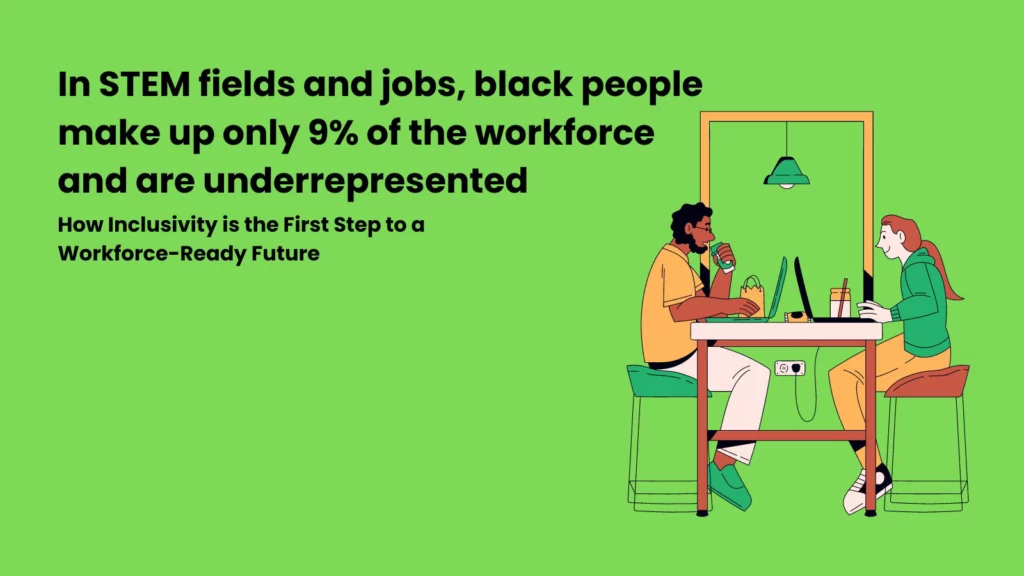Workforce readiness is about preparing youth to enter their careers. But what will that workforce look like? And what should it look like? While society has come a long way in the last few decades, there’s still a lot of work left to do.
In this article, we’ll explore the different demographics that are underrepresented in the workforce and explore ways to make the future workforce more inclusive.
VISIBLE MINORITIES
The current workplace underrepresents visible minority groups in a wide range of fields:
- In 2016, only 22% of science and engineering bachelor’s degrees were awarded to students of visible minority groups.
- In Canada’s largest businesses in, only 5.5% of board directors identify as visible minorities. About 1% are Indigenous.
- Only 9% of STEM workers are Black.
- In Canadian post-secondary education, university and college professors who identify as visible minorities tend to be both underpaid and underrepresented.
TAKEAWAYS
HR professionals recommend diversity and inclusivity training for leaders and employees covering:
- Bias and underrepresentation
- How to celebrate diversity within the workplace
- How to listen to minority groups with respect to representation, cultural differences, and language
GENDER AND SEXUAL IDENTITIES
Women have historically been underrepresented and underpaid compared to men, and they continue to face these challenges today.
- A Canadian census revealed that 36% of STEM-educated 30-year-olds were women.
- An American study found that only 19% of computer science bachelor’s degrees and 21% of engineering bachelor’s degrees were awarded to women.
- A 2020 report from the University of Ottawa revealed women earn about 25% less than men five years post-gradudation.
Non-heteronormative people also face barriers in the job market.
- Studies reveal that transgender people are less likely to hold full-time jobs and post-secondary degrees due to discrimination.
- 25% of LGBTQ+ respondents reported staying at a job because of an inclusive workplace, while 10% reported leaving a job due to discrimination.
- Another study found that LGBTQ2+ students are less likely to advance in STEM education and careers.
- While over 71% of heterosexual STEM students were retained by the fourth year of their STEM degree, only 64% of the LGBTQ students were retained.
Canada and the US have made some progress by updating their protected groups definitions to protect LGBT workers from workplace discrimination. Still, there is more work to be done to equalize the playing field for all gender and sexual identities in the workforce.
TAKEAWAYS
Career professionals and employers should continue making extra efforts to support women and LGBTQ+ youth with gaining employment — especially in the STEM fields — so that the future of work is more diverse and inclusive of all identities.
All gender and sexual identities should have a voice that is heard, be given equal opportunities to leadership roles and roles in STEM, feel comfortable in the workplace, and be encouraged to pursue their passions.
PEOPLE WITH DISABILITIES
“Disability” encompasses a wide range of conditions and levels of ability. Disabilities can be visible, like those that require wheelchairs or hearing aids, or they can be invisible, like mental illnesses.
- A large underrepresentation in jobs, historically and today, is the underrepresentation of people with disabilities.
- Estimates in 2015 put 400,000 working-age, willing Canadians with disabilities out of employment, which accounts for almost 60% of all working-age Canadians with disabilities.
- Unfortunately, people with disabilities are more than twice as likely to be in a state of low income than people without disabilities.
- Of Canada’s youth, one-third of those with severe disabilities have been refused a job because of their disability.
TAKEAWAYS
Some employers hold severe misconceptions about people with disabilities, assuming they will be less productive. Studies show that these notions are unfounded — in fact, some studies have shown workers with disabilities have been more productive than their colleagues without disabilities.
Moving forward, there must be more programs to encourage, train, and support youth with disabilities with employment opportunities.
Visible minorities, gender minorities, sexual minorities, and people with disabilities have faced marginalization both in the past and in the present. To build a truly ‘workforce-ready’ next generation, we need to be mindful of underrepresentation and foster a workforce that is inclusive of all people.

